
The Royal Australian Air Force (RAAF) is the principal air and space force of Australia, a part of the Australian Defence Force (ADF) along with the Royal Australian Navy and the Australian Army. Constitutionally, the Governor-General of Australia, is the de jure Commander-in-Chief of the Australian Defence Force. The Royal Australian Air Force is commanded by the Chief of Air Force (CAF), who is subordinate to the Chief of the Defence Force (CDF). The CAF is also directly responsible to the Minister for Defence, with the Department of Defence administering the ADF and the Air Force.
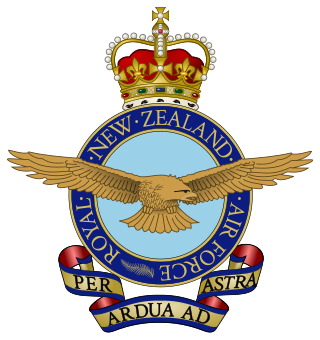
The Royal New Zealand Air Force is the aerial service branch of the New Zealand Defence Force. It was formed from New Zealand elements of the British Royal Air Force, becoming an independent force in 1923, although many RNZAF aircrew continued to serve in the Royal Air Force until the end of the 1940s.

RAAF Base Richmond is a Royal Australian Air Force (RAAF) military air base located within the City of Hawkesbury, approximately 50 kilometres (31 mi) North-West of the Sydney Central Business District in New South Wales, Australia. Situated between the towns of Windsor and Richmond, the base is the oldest base in New South Wales and the second oldest in Australia. The base is home to the transport headquarters RAAF Air Lift Group, and its major operational formations, Nos. 84 and 86 Wings. The main aircraft type operated at the base is the Lockheed C-130 Hercules. Richmond is a regular venue for air shows and had at times been mooted as a site for Sydney's proposed second international airport.

No. 30 Squadron is a squadron of the Royal Australian Air Force (RAAF). Raised in 1942 as a long-range fighter unit, the squadron saw action in the Second World War, serving in the South West Pacific Area against the Japanese and operating mainly in the ground attack and anti-shipping roles from bases in New Guinea and the Netherlands East Indies. After the war, the squadron was disbanded, however, it was re-raised a short time later as a unit of the part-time Citizen Air Force, operating in the target towing and air defence role in New South Wales. In 1960s the squadron ceased flying aircraft and operated surface-to-air missiles, providing for the defence of Sydney and Darwin before disbanding in 1968. The squadron was re-raised again in 2010 and since then it has served as an airbase support squadron located at RAAF Base East Sale.

No. 36 Squadron is a Royal Australian Air Force (RAAF) strategic transport squadron. It operates Boeing C-17 Globemaster III heavy airlifters from RAAF Base Amberley, Queensland. The squadron has seen active service flying transport aircraft during World War II, the Korean War, the Indonesia–Malaysia Konfrontasi, the Vietnam War, and the wars in Afghanistan and Iraq. It has also supported Australian humanitarian and peacekeeping operations around the world, including Somalia, Cambodia, East Timor and Indonesia.
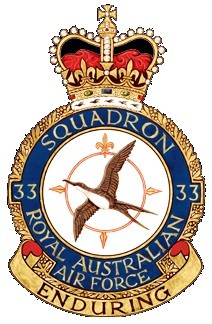
No. 33 Squadron is a Royal Australian Air Force (RAAF) strategic transport and air-to-air refuelling squadron. It operates Airbus KC-30A Multi Role Tanker Transports from RAAF Base Amberley, Queensland. The squadron was formed in February 1942 for service during World War II, operating Short Empire flying boats and a variety of smaller aircraft. By 1944 it had completely re-equipped with Douglas C-47 Dakota transports, which it flew in New Guinea prior to disbanding in May 1946.

No. 34 Squadron is a Royal Australian Air Force (RAAF) VIP transport squadron. It operates Boeing 737 Business Jets and Dassault Falcon 7Xs from Defence Establishment Fairbairn in Canberra. The squadron was formed in February 1942 for standard transport duties during World War II, initially flying de Havilland DH.84 Dragons in Northern Australia. In 1943 it re-equipped with Douglas C-47 Dakotas, which it operated in New Guinea and the Dutch East Indies prior to disbanding in June 1946.
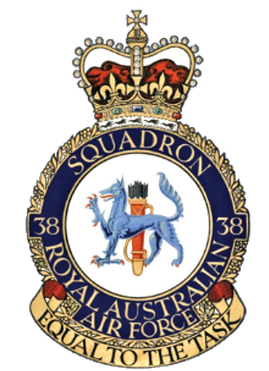
No. 38 Squadron was a Royal Australian Air Force (RAAF) transport and training unit active between 1943 and 2018. It was formed on 15 September 1943 and saw service during World War II transporting supplies and personnel between Australia and the combat zones in New Guinea and Borneo, using Douglas Dakota aircraft. Following the war, the squadron conducted regular courier flights between Australia and Japan in 1947 and 1948. No. 38 Squadron was deployed to Singapore from 1950 to 1952, supplying Commonwealth forces engaged in the Malayan Emergency and undertaking courier flights across Asia. In 1954 it became responsible for training RAAF personnel to operate Dakotas.

No. 5 Squadron was a Royal Australian Air Force training, army co-operation and helicopter squadron. The squadron was formed in 1917 as a training unit of the Australian Flying Corps in Britain, readying pilots for service on the Western Front. It subsequently became a naval fleet co-operation squadron, but was later redesignated as No. 9 Squadron RAAF before being re-formed as an army co-operation squadron during World War II. In the mid-1960s, it was re-formed as a helicopter squadron, before being disbanded in December 1989, when it was used to form the Australian Defence Force Helicopter Training School.

No. 86 Wing is a Royal Australian Air Force (RAAF) transport and air-to-air refuelling wing. Coming under the control of Air Mobility Group, it is headquartered at RAAF Base Amberley, Queensland. The wing comprises No. 33 Squadron, operating Airbus KC-30 tanker-transports, No. 36 Squadron, operating Boeing C-17 Globemaster III heavy transports, and the Australian Army's 68 Ground Liaison Section. Its aircraft support Australian military and humanitarian operations worldwide.

No. 84 Wing is a Royal Australian Air Force (RAAF) transport wing. Coming under the control of Air Mobility Group (AMG), it is headquartered at RAAF Base Richmond, New South Wales. The wing comprises No. 35 Squadron, operating Aliena C-27J Spartan transport Aircraft; No. 37 Squadron, operating Lockheed Martin C-130J Super Hercules medium transports; and a technical training unit, No. 285 Squadron.
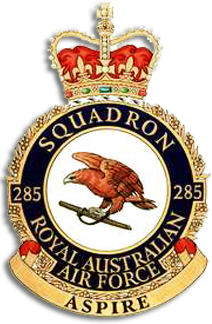
No. 285 Squadron was a Royal Australian Air Force (RAAF) training squadron. Controlled by No. 84 Wing, the squadron was formed in August 1999 to train the RAAF's Lockheed Martin C-130J Hercules aircrew and ground support staff. No. 285 Squadron did not control any flying aircraft but managed the flight simulator used for converting aircrew to the C-130Js operated by No. 37 Squadron. It was also allocated decommissioned Hercules airframes for training purposes, as well as flying aircraft from No. 37 Squadron when required. Throughout its existence, No. 285 Squadron was located at RAAF Base Richmond in the western suburbs of Sydney. The squadron was disbanded in December 2017.

No. 22 Squadron is a Royal Australian Air Force (RAAF) mixed Permanent and Reserve squadron that provides support for the RAAF in the Sydney region. Formed in 1936, the squadron served in Papua New Guinea during the Second World War, and later followed the Pacific War as far as the Philippines. Following the war, the squadron was re-formed in 1948 but was converted to a non-flying support role in mid-1960. It is currently based at RAAF Base Richmond, New South Wales.

No. 35 Squadron is a Royal Australian Air Force (RAAF) transport unit. Formed in 1942, No. 35 Squadron operated during World War II, transporting cargo and passengers around Australia, New Guinea and the Netherlands East Indies, equipped with a variety of aircraft including the Douglas Dakota. It was disbanded after the war, but was re-raised in the 1960s for service during the Vietnam War, flying transportation and resupply operations with DHC-4 Caribous in support of Australian and US forces. The squadron was subsequently augmented with rotary-wing aircraft, operating UH-1 Iroquois in both the transportation and gunship roles. In the late 1980s, the squadron returned to a solely fixed-wing transport role. It ceased operations in 2000, but was re-raised in January 2013. It began re-equipping with C-27 Spartan transports in 2015.

Transport Flight (Japan) was a Royal Australian Air Force (RAAF) transport unit that operated in the aftermath of the Korean War. It was formed in March 1955 at Iwakuni, Japan, and equipped with three Douglas C-47 Dakotas and a CAC Wirraway. The flight's main duty was flying a regular courier service between Japan and South Korea in support of Commonwealth military units based on the peninsula. Transport Flight (Japan) ceased operations in June 1956 and disbanded in September that year.

Air Marshal Sir Alister Murray Murdoch, was a senior commander in the Royal Australian Air Force (RAAF). He served as Chief of the Air Staff (CAS) from 1965 to 1969. Joining the Air Force in 1930, Murdoch trained as a seaplane pilot and participated in an Antarctic rescue mission for lost explorers in 1935. During World War II, he commanded No. 221 Squadron RAF in Europe and the Middle East, and later occupied senior positions on the staff of RAAF formations in the South West Pacific. His post-war appointments included Commandant of RAAF College from 1952 to 1953, Air Officer Commanding (AOC) Training Command from 1953 to 1955, Deputy Chief of the Air Staff from 1958 to 1959, and AOC Operational Command from 1962 to 1965.
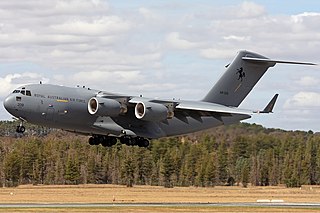
The Royal Australian Air Force (RAAF) operates eight Boeing C-17 Globemaster III large transport aircraft. Four C-17s were ordered in mid-2006 to improve the ability of the Australian Defence Force (ADF) to operate outside Australia and its region. The aircraft entered service between November 2006 and January 2008, the second pair being delivered ahead of schedule. Two more Globemasters were ordered in 2011, the sixth being delivered to the RAAF in November 2012. Another two C-17s were ordered in October 2014, with the final aircraft being delivered in November 2015. The Globemasters are built to the same specifications as those operated by the United States Air Force (USAF), and the Australian aircraft are maintained through an international contract with Boeing.
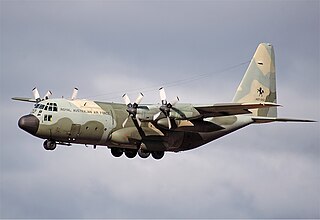
The Royal Australian Air Force (RAAF) has operated forty-eight Lockheed C-130 Hercules transport aircraft. The type entered Australian service in December 1958, when No. 36 Squadron accepted the first of twelve C-130As, replacing its venerable Douglas C-47 Dakotas. The acquisition made Australia the first operator of the Hercules after the United States. In 1966 the C-130As were joined by twelve C-130Es, which equipped No. 37 Squadron. The C-130As were replaced by twelve C-130Hs in 1978, and the C-130Es by twelve C-130J Super Hercules in 1999. No. 37 Squadron became the RAAF's sole Hercules operator in 2006, when No. 36 Squadron transferred its C-130Hs before converting to Boeing C-17 Globemaster III heavy transports. The C-130Hs were retired in November 2012, leaving the C-130J as the only model in Australian service.

No. 90 (Composite) Wing was a Royal Australian Air Force (RAAF) wing that operated during the early years of the Malayan Emergency. Its purpose was to serve as an umbrella organisation for the RAAF units deployed in the conflict, No. 1 (Bomber) Squadron, flying Avro Lincolns, and No. 38 (Transport) Squadron, flying Douglas C-47 Dakotas. The wing was established in July 1950 and headquartered at Changi, on the east coast of Singapore. No. 1 Squadron operated from Tengah, in Singapore's west. No. 38 Squadron was based at Changi and, from April 1951 to February 1952, at Kuala Lumpur in central Malaya. The Lincolns generally conducted area bombing missions, as well as precision strikes, to harass communist insurgents. The Dakotas were tasked with airlifting cargo, VIPs, troops and casualties, as well as courier flights and supply drops. Following No. 38 Squadron's departure in December 1952, No. 90 Wing was disbanded, leaving No. 1 Squadron to carry on as the sole RAAF unit in the Malayan air campaign until its withdrawal to Australia in July 1958.

No. 486 Squadron was a maintenance unit of the Royal Australian Air Force (RAAF). It was formed in August 1946 as part of No. 86 (Transport) Wing, which operated Douglas C-47 Dakotas out of RAAF Station Schofields, New South Wales. The squadron transferred to RAAF Station Richmond in June 1949. It relocated again to RAAF Base Canberra in April 1954, before returning to Richmond in August 1958 to commence maintenance of No. 86 Wing's newly delivered Lockheed C-130 Hercules. The squadron was disbanded between August 1964 and March 1966. In the 1980s and 1990s, it was responsible for servicing the RAAF's Boeing 707 tanker/transports, as well as the Hercules. No. 486 Squadron was again disbanded at Richmond in October 1998, and its functions handed over to No. 86 Wing's Hercules squadrons.

























